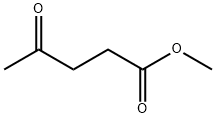Butyl levulinate
- CAS NO.:2052-15-5
- Empirical Formula: C9H16O3
- Molecular Weight: 172.22
- MDL number: MFCD00009449
- EINECS: 218-143-4
- SAFETY DATA SHEET (SDS)
- Update Date: 2025-12-17 09:49:53

What is Butyl levulinate?
Chemical properties
Butyl levulinate has a sweet and slightly pungent caramellic odor with fruity undertones; mild sweet caramellicherbaceous taste; bitter taste.
The Uses of Butyl levulinate
Butyl levulinate was used in the synthesis of γ-valerolactone.
The Uses of Butyl levulinate
Butyl 4-Oxopentanoate is used in preparation and application of magnetic nano-solid acid catalyst iron oxide-polydopamine-sulfonic acid
What are the applications of Application
Butyl levulinate is a derivative chemical of levulinic acid, from agricultural residue (rice straw)
Definition
ChEBI: Butyl levulinate is an oxo carboxylic acid.
Production Methods
Butyl levulinate can be produced by direct esterificalion of n-Butyl alcohol with Levulinic acid.
Synthesis Reference(s)
Tetrahedron Letters, 31, p. 3063, 1990 DOI: 10.1016/S0040-4039(00)89026-7
Flammability and Explosibility
Not classified
Properties of Butyl levulinate
| Boiling point: | 106-108 °C5.5 mm Hg(lit.) |
| Density | 0.974 g/mL at 25 °C(lit.) |
| vapor pressure | 5Pa at 25℃ |
| FEMA | 2207 | BUTYL LEVULINATE |
| refractive index | n |
| Flash point: | 197 °F |
| storage temp. | 2-8°C |
| form | clear liquid |
| color | Colorless to Almost colorless |
| Specific Gravity | 0.974 |
| Odor | at 100.00 %. fruity herbal waxy caramel savory |
| Water Solubility | Slightly soluble in water. |
| JECFA Number | 608 |
| CAS DataBase Reference | 2052-15-5(CAS DataBase Reference) |
| NIST Chemistry Reference | Pentanoic acid, 4-oxo-, butyl ester(2052-15-5) |
| EPA Substance Registry System | Butyl levulinate (2052-15-5) |
Safety information for Butyl levulinate
| Signal word | Warning |
| Pictogram(s) |
 Exclamation Mark Irritant GHS07 |
| GHS Hazard Statements |
H315:Skin corrosion/irritation H319:Serious eye damage/eye irritation |
| Precautionary Statement Codes |
P280:Wear protective gloves/protective clothing/eye protection/face protection. P302+P352:IF ON SKIN: wash with plenty of soap and water. P305+P351+P338:IF IN EYES: Rinse cautiously with water for several minutes. Remove contact lenses, if present and easy to do. Continuerinsing. P332+P313:IF SKIN irritation occurs: Get medical advice/attention. P337+P313:IF eye irritation persists: Get medical advice/attention. |
Computed Descriptors for Butyl levulinate
| InChIKey | ISBWNEKJSSLXOD-UHFFFAOYSA-N |
New Products
4,4-Difluoropiperidine hydrochloride tert-butyl 9-methoxy-3-azaspiro[5.5]undecane-3-carboxylate Indole Methyl Resin N-Isopropylurea N,N-Dicyclohexylcarbodiimide(DCC) MELDRUMS ACID 5-METHYLISOXAZOLE-4-CARBOXYLIC ACID Magnessium Bis glycinate Zinc ascorbate 1-bromo-2-butyne 2-acetamidophenol 9(10H)-anthracenone Erythrosin B, 4-Piperidinopiperidine 2-((4-morpholinophenylamino) (methylthio) methylene) malononitrile 2,4-dihydroxybenzaldehyde 3-(4-morpholinophenylamino)-5-amino-1H-pyrazole-4-carbonitrile Methyl 2-methylquinoline-6-carboxylate 2,6-dichloro-4-nitropyridine 4-Bromo-2-chlorobenzonitrile 2-(benzylamino)acetic acid hydrochloride 4-(tert-Butoxycarbonylamino)but- 2-ynoic acid 3,4-dihydro-2H-benzo[b][1,4]dioxepine 1-Phenyl-1-cycloprppanecarboxylicacidRelated products of tetrahydrofuran








You may like
-
 Butyl Levulinate CAS 2052-15-5View Details
Butyl Levulinate CAS 2052-15-5View Details
2052-15-5 -
 Butyl Levulinate CAS 2052-15-5View Details
Butyl Levulinate CAS 2052-15-5View Details
2052-15-5 -
 3-(4-amino-1-oxoisoindolin-2-yl)-1-methylpiperidine-2,6-dione 98%View Details
3-(4-amino-1-oxoisoindolin-2-yl)-1-methylpiperidine-2,6-dione 98%View Details -
 614-19-7 98%View Details
614-19-7 98%View Details
614-19-7 -
 20677-73-0 (2,2-diethoxyethyl)methylamine 98%View Details
20677-73-0 (2,2-diethoxyethyl)methylamine 98%View Details
20677-73-0 -
 3-(4-(hydroxyamino)-1-oxoisoindolin-2-yl)piperidine-2,6-dione 98%View Details
3-(4-(hydroxyamino)-1-oxoisoindolin-2-yl)piperidine-2,6-dione 98%View Details -
 57381-49-4 2-bromo-4-chlorobenzonitrile 98%View Details
57381-49-4 2-bromo-4-chlorobenzonitrile 98%View Details
57381-49-4 -
 4,6-dichloropyrimidine-5-carbaldehyde 98%View Details
4,6-dichloropyrimidine-5-carbaldehyde 98%View Details
5305-40-8
Statement: All products displayed on this website are only used for non medical purposes such as industrial applications or scientific research, and cannot be used for clinical diagnosis or treatment of humans or animals. They are not medicinal or edible.
